The only French lesbian comics I know (I found them either in Paris or in Montreal, I forget). Half of it concerns the amorous intrigues of a communeful of oddly named dykes (Psapfa, Zaralk, Ellk, Diaf'...), which is very readable; the other half consists of one character's discovery of lesbian literature, which would come across as more evolved if it didn't depend so much on dissing other sexualities. But they say to write what you know... Arbrelune is a feminist writer who lived (with the artist) on a farm in the middle of nowhere.
The adventures of a pirate band, prominently featuring two pirate babes, the plot seemingly designed to give as many excuses for nudity and sex as possible.
Jurassic Girls
The same formula, applied to the Pleistocene. It actually works better, simply because the brazenness of the anachronisms becomes comic: bone and tortoise-shell sunglasses, bone-marrow six-packs...
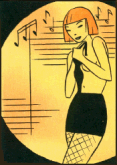 Avril & Petit-Roulet
Avril & Petit-Roulet
Short stories about what hard work hedonism is. There's no dialogue, and the style is bright and stylized, rather in the manner of the '30s New Yorker. It's cute, and certainly not like any US comics.
La Femme Piège [The Woman Trap]
Froid Equateur
What'll strike you first about Bilal is his art: the panels are veritable paintings, reminiscent of Moebius at his best. What'll strike you next is the art, but at a deeper level: the subtle, somber colors, the sureness of composition, the febrile creativity, all creating an air of macabre mystery. Then, the milieu: a seedy fascist Paris of the future, with extraterrestrials and Egyptian gods thrown in... Finally, the writing, spare, adding to the art without making the fatal mistake of explaining everything. The mood is dark, but never gives in to the mere nastiness which infects many European and underground cartoonists; rather, an Eastern European sense of horror and melancholy.
A beautifully drawn, completely obscure story, which seems to make the rather unnecessary point that it might not be such a good idea to have no emotions.
"Parodic and caustic portrait of the average Frenchman."
A webcomic, "superficially about the life of a 30-something Parisian nerd-- though it often derives into SF and fantasy; it's usually really funny, and sometimes beautifully drawn. (It must be the only webcomic I know that features the occasional watercolor strip, and the author's influences range from Moebius to Watterson). " --Mathieu
Boulet has quite a number of albums to his name as well.
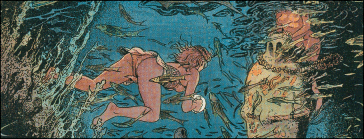
"Period: medieval, Hundred Years War (start of each volume: 'They say this one will last a hundred years'); more (vols. 1-2) or less (vol. 3) fantastic. Very poetic; the dialogue is more or less free verse, but it's so well done that you may not even realize it. Extraordinary research and art, especially in the last volume (Le dernier chant des Malaterre), one of the best BDs I've ever read. It has everything,: action, emotion, humor, a bit of magic, a tincture of eroticism, but nothing vulgar. In short, a very great series, to be read and re-read."
Couldn't have said it better myself. Beautiful albums.
News flash-- I just found the first volume in English-- The Spell of the Misty Wood or something. Not well printed, and badly translated, but better than not reading it at all...
Le Cycle de Cyann 1993
Science fiction this time; the plot of this two-volume story has something to do with an expedition to thwart a plague, but that hardly matters; the thing here is the extraordinary richness of the creation. An entire world is evoked, from its architecture to its flora and fauna to its complex culture; and the characters are as full of life and detail as the drawings. J'ose dire, the best of recent BD series.
A Tintin for the new milennium, perhaps-- though Jules is a bit more reluctant hero than Tintin, and burdened with a fatuous father and annoying younger brother, as well. And this time a girl teen gets to join the adventure as well. The adults are nicely satiric; I particularly liked the Japanese pilot who's had his eyes surgically enlarged to manga proportions.
How French intellectuals think and relate. Rarely what I'd call funny, but interesting from a sociological point of view.
"Calvo was the funny animal artist in France, and this is his most impressive book." An allegorical retelling of WW2.
Straight-ahead adventure, with a low-rent, contemporary flavor (Westerners misbehaving themselves in India). Captifs du chaos in particular has the feel of a film noir-- this could have been a Bogart flick.
A tale of sorcery and decadence in late colonial India and Malaysia, complete with a beautiful but devious prostitute, a brutal ship captain, a ghost, a lecherous vizier, and of course a French near-innocent to identify with.
Western adventures. Not my scene, but notable for Giraud (= Moebius)'s art.
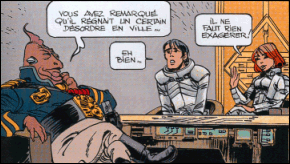
A wonderful discovery. Most comics with art this fantastic and imaginative have awful stories, shallow or self-indulgent. But Christin's stories are every bit as strong as Mézières's evocative visuals. There's a nice satirical edge, as well as the sense of a busy, interesting galactic culture. And Valérian's partner Laureline is very easy to look at.
The first 10 albums or so are probably the most rewarding.
Valentina is of course Crepax's S-M victim-heroine. #2 is a bit too strange to be completely erotic: Crepax is more turned on by Victorian dominatrixes and enemas than I am. #1 is, surprisingly enough, a superhero adventure story, "in Crepax's very own cool '60s pop style," as the cover puts it. Notable for its advanced storytelling techniques, with a heavy use of aspect-to-aspect and moment-by-moment panel transitions.
Kevin is a boy of about 8, with a biker dad, his own motorcycle, and what he calls, en franglais, rock & roll attitude.
"I'm particularly fond of this, the story of his parents' working life, and involvement in the rise of the Socialist party, from 1950 to François Mitterand's election in 1981. It's a quite beautiful depiction of working-class life in post-WW2 France, and of the fascinating history of the French Christian left, both of which tend to be omitted from history books.
The rest of his work is excellent as well; his most recent one is Lulu, femme nue, which I recommend highly." --Mathieu
Stories of a run-down aristocratic family. For anyone whose aristophilia isn't exhausted by P.G. Wodehouse, I suppose. Competently drawn (Mme de la Houpe is pretty cute) and written well enough. One story I read, about the aristo's vision of God as a chicken, was amusing enough; another, about the punk maid's failed attempt to rebel, seemed to live on the wrong side of the class war.
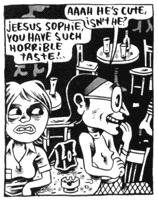 Julie Doucet
Julie Doucet
A Québécoise alternative artist-- mostly dream stories, in a busy, hallucinatory B&W style.
M. Jean is a rather nebbishy Parisian writer, with a real gift for having bad luck with women, being put upon by his friends, and arousing the suspicions of his concierge. Amusing and well-drawn in a cartoony style (reminiscent of Seth in fact).
Short stories set in Provence. The art is spectacular and will make you want to go there; but if you do you might end up as the subject of one of Ferrandez's engaging, ironic vignettes. Both the beauty of the landscape and the endearing hardheadedness of the inhabitants are captured here, as in Marcel Pagnol.
Big-business adventures, of all things.
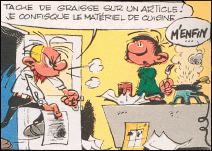 Franquin
Franquin
"Very nice anti-hero." "The Gaston series is a must, in my opinion; it's easy to find and includes just a dozen albums."
M'enfin! Part of the basic repertoire of any reader of French BDs. Amusing tho' not deep, to an American reader. Gaston is the ne'er-do-well mail clerk in a Belgian publishing house, constantly annoying his straight-arrow boss Fantasio (himself a major character in the Spirou series) with his laziness, his pets, his inventions, or mere clumsiness.
Les aventures de Spirou et de Fantasio
1946
"Each [Spirou album] is fresh and original." Some Spirou stories (basically adventure stories aimed at kids) are now being published in English by Fantasy Flight. This series also introduced the Marsupilami, a fanciful creature who has apparently now become a star on the Disney Channel.
Idées Noires
Black humor (drawn all in silhouettes).
Fred, author of the '60s fantasy strip Philémon, returns with this Kafkaesque fable of a man who wakes up turned into a crow. Not quite like anything else, though Jules Feiffer and Krazy Kat come to mind.
Les célibataires 1991
Some of my favorite erotica: sexy but never nasty. Célibataires in particularly also has a dramatic two-tone look, very elegant. It's also a nice satire on promiscuity: although the hero (vacationing with his family in Antibes) will do almost anything to get a girl into bed, his schemes generally only land him deeper and deeper in trouble.
The story of a love triangle; not at all memorable, but drawn in an elegant retro style.
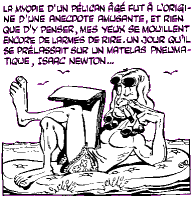
Rhââ Lovely
Rubrique-à-brac 1970
Never say that the French have no sense of the ridiculous. Gotlib has read Mad, and it shows. You'll never look at Isaac Newton the same way again.
How the French view superhero comics: they think they're a hoot. Superdupont is a French superhero, complete with paunch, slippers, and Basque beret. One of the funniest conceits of the series is his nemesis: a shadowy organization called Anti-France, whose black-clad agents are all foreigners and thus speak, not any particular language, but foreigner-talk, a mishmash of English, Spanish, Russian, and German.
A satirical strip featuring rotund, orotund Achille Talon, his put-upon neighbor Hilarion Lefuneste, salesman Vincent Poursan (which sounds like "2000%"), and others, filled with slapstick, absurd machinery, and outrageous puns. All the characters speak in excesses of rhetoric which are fairly amusing if your French is up to the challenge.
Achille is now appearing on American TV, renamed Walter Melon, and apparently rather Americanized-- e.g. he has a supervillain nemesis.
Adventure, humor, heroism, friendship, master storytelling, master cartooning; what else could you want?
Les aventures de Jo, Zette et Jocko
An editor thought, astonishingly, that Tintin did not sufficiently reinforce family values, and prevailed on Hergé to write these stories, featuring a younger hero and heroine firmly provided with parents.
Quick et Flupke
Gags centering round two Brussels street urchins, from early in Hergé's career.
Adventure tales intended as futuristic, but now curiously expressive of period, lovingly recreating postwar London as well as the infinitely straight heroes of an even earlier period (living sexlessly together à la Holmes and Watson). Jacobs was an associate of Hergé, whose influence (though not his wit) shows.
What the French ados are reading: satirical sf with a bad-girl(-cat) heroine who is not, let us say, deprived sexually. The slang is thick enough to cut with a knife. The art is sort of a cartoony post-Moebius.
Après la pluie [After the rain] ~ 1998
The sort of casually competent grownup comics Gary Groth would kill to have here in abundance. I read the second of these, a mystery: an artist has disappeared, with his girlfriend; the only clue is a picture of the two of them captured by a random photographer. Very nicely drawn.
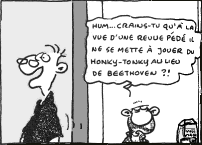 Ralf König
Ralf König
König chronicles the German gay scene, with enough humor, humanity, and outrageousness to win a following among hep hets as well. Both of these have been made into movies in Germany, and are now available in English translation. Condom, whose title accurately describes the subject, is a little masterpiece of screwball horror.
There are oodles of König titles, notably an ongoing series, Conrad and Paul.
You may know König from The Killer Condom, which has been made into a movie. The title accurately describes the subject.
Franka is a detective who specializes in art crimes. I haven't seen these Dutch comics myself, but a correspondent says they're "stunning", and recommends starting with #10.
He's mostly known for his more serious work Le combat ordinaire (four volumes) is the story of a neurotic photographer struggling with adulthood: in the course of the series, he'll leave the Paris suburbs for a house in the countryside, deal with his relationship, fatherhood and the death of his father. There's a quite moving - in my opinion - evocation of working-class France in the second part.
His later work, Blast (in progress, two volumes have been published) starts with a police investigation: why did the protagonist brutally assault a young woman? Larcenet then follows the story of that man who, after a strange epiphanic experience (which he calls the Blast), abandons his life as a writer for a strange journey, which will lead him from a strange community of homeless people to the moai of Easter Islands. The story is interesting enough; but its main interest in the art: Larcenet has developped a particuliar - and often stunningly beautiful - style." --Mathieu
Leloup must have spent too much time reading the Belgian equivalent of Popular Mechanics-- he's given not only to drawing huge gleaming technological structures, but to expatiating on how they work. The appropriately high-tech title heroine is an électronicienne who, Tintin-like, faces adventures boldly and with a little more on the ball than her companions. She's not bad as a heroine, except for the colorist's unfortunate belief that the Japanese are actually colored pale yellow, like a Post-it note.
Barney ou la Note Bleue
"Several wonderful comic books with slightly sinister stories... Loustal uses very large panels and draws everything (including contours) with a brush. His drawing style looks almost childish at first glance and becomes beautiful and nightmarish upon further inspection. ...There are also some remarkable Loustal solos which typically feature short stories."
A photographer exploring a remote marsh finds himself inexplicably thrown in prison-- a huge, rambling dungeon, where no one can tell him who their captors are. Escaping is only one of the puzzles he faces. Leisurely, captivating, and a little macabre.
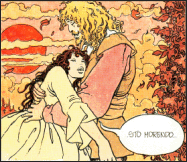
A nice piece of work: a thought-provoking reflection on what it means to have an adventure, whether just anyone can have one, and what living in the media age does to us. Also a tribute to Hugo Pratt.
Jour de colère
Trip to Tulum
More surrealist adventure. The latter is a collaboration with
Federico Fellini and "a lovely trifle", as Eli Bishop calls it.
Le déclic [Click]
Le parfum de l'invisible
Butterscotch 1992
Candid Camera [Hidden Camera] 1993
"In erotic BDs, the incontested master... Gotta love 'im. :)"
Like so many Euro comics, well done, but not good for you. Manara's erotic strips leave a bad taste in the mouth; they're heavy on voyeurism and humiliation, tho' nothing like so disturbing as Guido Crepax. He sure can draw, tho'.
Les aventures galactiques de Roger Bacon 1990s
From the bit I've seen of the 'Masked Cucumber', he seems to be something like Bugs Bunny in a bad mood-- the resourceful, language-mangling victim of rather stupid opponents-- combined with some very '60s psychedelia. Gotlib loved to parody le Concombre, as well as his favorite expression "Vas-y Léon!" (which appears in the Italian magazine Linus as "Vaccileone!").
You can get a sample of the Cucumber in English at Mandryka's site.
Kind of the serious version of Astérix. Maurice Horn says, "Alix is an outstanding adventure strip depicted with an almost archeological knowledge of the period."
In a fantasy Venice subject to near-absolute-zero chills, volcanos, and invasions of giant lobsters, where the buildings are hung out to dry after a rain, two old men stand on a balcony and chat about science-- chaos theory, neoteny, quantum mechanics, superfluidity, symmetry. One is up on all the latest theories; the other reduces them all to quotidian nonsense. It's thoroughly strange, occasionally quite funny, sometimes baffling. The art, which imitates engraving, is gorgeous.
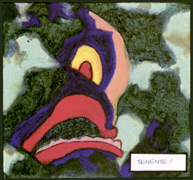
A battleship is sent to investigate a remote island, seemingly peaceful, but harboring some sort of dangerous horror. The story is mostly an excuse to display some amazing expressionistic artwork.
Max is a prolific Spanish artist with an elegant, caricatury style; the stories here (by Beltrán) are about femmes fatales, and are a little vacuous as a result-- the women are just pinups. The best one is about a man in love with a pair of very contentious Siamese twins.
Le Bandard fou
Arzach 1973
The Long Tomorrow 1989
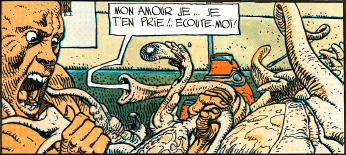 Moebius was one of the founders of the Métal Hurlant/Heavy Metal look: Arzach introduced panels that were virtually paintings. The Arzach stories have an undeniable oneiric attraction; Moebius explains that he was reaching deep into his subconscious for these images, and that when you do that you tend to end up with something dark and strange.
Moebius was one of the founders of the Métal Hurlant/Heavy Metal look: Arzach introduced panels that were virtually paintings. The Arzach stories have an undeniable oneiric attraction; Moebius explains that he was reaching deep into his subconscious for these images, and that when you do that you tend to end up with something dark and strange.
Moebius is often at his best illustrating another's story (as in The Long Tomorrow or L'Incal, below); his own stories can be incoherent. But the art is always breathtaking.
Moebius is one of the few French artists who's relatively easy to find in translation.
Toto, I don't think we're in the Marvel Multiverse anymore. An exploration of a strange, corrupt, complicated, often nightmarish future world. This is the kind of thing that can be done only through comics-- not that many people in the field even try. A novel would make it seem watery and incomprehensible; a movie either wouldn't do it justice, or it would be about the effects not the story.
John Difool is an ordinary schmuck ('a class R private dick') who comes into possession of the Incal, a mystical tetrahedron also sought by everyone from the President (who is cloned, not elected) to the underground to the Technos to aliens from another galaxy. The story is good, tho' it never quite fulfils its potential-- an interesting crew of characters accumulates round John, but is less interesting as a group than separately; a spiritual dimension found in the first book is never really pursued. The art, on the other hand, never ceases to be phenomenal: Moebius moves from one striking image to another.
NB: Moebius along with Mézières (of Valérian) were the designers for Luc Besson's recent film The Fifth Element, which therefore has some of the same visual flair of their BDs, and even some of the feel of L'Incal (and that was it, perhaps-- but you have to admit, it was something to look at, that film.)
French kids read all of these by their tenth birthday-- if you're after yours, you may not need to. The one I read was OK, but not worth a detour, as the Michelin would say. If you want to check them out (and an English-translated series is now coming out) Francophone readers advise that the ones scripted by Goscinny (of Astérix fame) are the best.
A Valérian for the turn of the century... the heroine is Nävis, a teenage girl who's picked up by the Sillage, an enormous multi-civilization colonization convoy, becoming the only representative of humanity. They're nicely drawn, and Nävis is an appealing character, but it's not as odd as the most interesting French sf comics-- the aliens and their politics are awfully reminiscent of the European Union.
I haven't seen these myself, but a correspondent pointed them out: "gay BD... quite a rarity in France."
...known in Spanish as los Pitufos, or in English as, oh dear yes, the Smurfs. Yes, the original perpetrator was Belgian. Just remember, anything is more sophisticated in French. :) The early albums are said to be the best.
Johan et Pirlouit [Johan and Peewee]
1947
The Smurfs are actually a spinoff of this series, about two boys living in medieval times. As kids' stories, they're pretty entertaining.
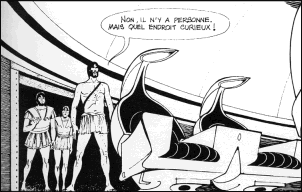
What I love about Ulysse is its basic premise: the ancient Greek gods were actually extraterrestrials, effortlessly dominating the credulous mortals with high technology. "Of course," you'd say if you were me, "that's exactly how it had to be." It seems the gods go to the same costume shop as Barbarella.
Pichard has also produced illustrated versions of Carmen, Sacher-Masoch, and the Kama Sutra, for those so inclined.
Short stories, beautifully drawn and colored, mostly astringent satires of petty prides and rigidities in modern Spain.
"Magnificent art, ultra-researched scripts, it's a must! I prefer Les Celtiques, Corto en Sibérie, Fable de Venise, les Ethiopiques. Originally in black and white, the albums are being republished in color (respecting the author's intentions, but obviously it's a debate which divides his fans :). I'm not so fond of the later albums (les Helvétiques, Mu), which drop too easily into long delirious dream sequences."
El Gaucho
Indian Summer: A long and beautiful album, historical fiction, with enough eroticism, barbarism and anticlericism to remind you that this is Manara-land.
Quino is Argentine; see my page on Latin American comics, or Bob's fuller review.
I heard about Melody through a rave write-up in the Montreal press. It's an autobiography: Sylvie Rancourt is a stripper, and before that, lived in Auboutte de Toute ("Nowheresville"), Québec, where she and her boyfriend hosted, er, orgies.
This is not Omaha. Rancourt is not ashamed of what she does, but she does tell it like it is, from jerky boyfriends to family disapproval to troubles with the law.
Melody is most widely available in English, redrawn by Jacques Boivin; it was originally drawn by Rancourt in French, and is worth seeking out; she has a charming naïf style.
Vive les Vacances
On vit une époque formidable
Phantasmes
More sixties humor: the drawing skills of Wolinski (or let's say Wayne Stayskal), combined with the humoristic punch of François Mitterand (or let's say The Lockhorns).
A correspondent suggests that I've only seen the bad stuff-- some of his '60s/'70s albums (e.g. those listed) are supposed to be devastatingly satirical.
Where superheroes predominate in the US, fantasy does in francophone BDs; Thorgal is one of the best. The drawing is realistic (and with better printing and coloring available, French comics have to be drawn about five times as well as American comic books to look good), and the scripts are extremely well done-- full of notable characters, suspense, humor, and neat tricks. A good one to start with is Les Archers (The Archers), 9th in the series but an excellent standalone story.
Bronze Age adventure: Tiresias is a Theban warrior with a weakness for women. When he goes after one of Athena's virgin priestesses, the goddess punishes him by turning him into a woman. Well done, and spectacularly drawn.
 François Schuiten & Benoît Peeters
François Schuiten & Benoît Peeters
La Tour [The Tower] 1987
La fièvre d'Urbicande [Fever in Urbicand] 1987
Les Murailles de Samaris [The Great Walls of Samaris] 1988
Strange fantasies, something like a Borges fable turned into comics. Schuiten's engraving-like portraits and architectural vistas are something to see; and the stories have a meaty sense of mystery to them.
Many of these are available in English.
American readers may know Sempé from his cartoons in the New Yorker. He's something like a cross between a New Yorker cartoonist and Sergio Aragones.
A young boy makes friends with a number of monsters. American readers may think of Charles Addams; but the French are able to do this sort of thing without getting either cutesy or camp. Also see his collaboration with Tronheim, Donjon.
Hard-boiled detective stories told with funny animals. That's 'funny animals' meaning the genre: these animals are actually rather nasty-looking. Fairly well done, tho' we've gone down these dark alleys with this sort of detective many times before. The coloring and some special effects seem to be done with computer graphics, which adds an interesting touch.
These French cartoonists have done a series of luridly drawn parodies of American icons-- Disney, Superman-- and the Pope as well, more or less in the Philip José Farmer tradition of "Let's take this archetype and add a lot of sex to it."
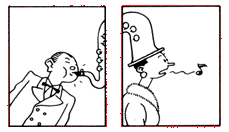
Yet more cheating: a Dutch artist this time.
Definitely bad for you-- like many a European artist, Swarte's mind is deeply twisted-- but ooh, that sense of style. "Jazzy elegance," Scott McCloud calls it. His Art Deco buildings are awesome; his Tintinish characters are perplexing; and every once in a while he wows you with some totally gratuitous three-point perspective.
Iznogoud is the Grand Vizier in Baghdad, and his great and only goal is to become caliph in place of the caliph-- a rotund bonhomme who, by contrast, has utmost faith in his vizier, perhaps because Iznogoud's luck is on a par with Wile E. Coyote's. By the same writer as Astérix; amusing tho' not memorable.
Period Gothic adventures, featuring the melancholy lace-collar criminal Adèle, a gallery of bowlered and moustachioed gentlemen, and assorted supernatural horrors. Meticulously drawn, well written, and closely plotted, these are some of the best French BDs.
The first two are Adèle et la Bête and Le Démon de la Tour Eiffel.
Brouillard au pont de Tolbiac
120 rue de la Gare
Casse-pipe à la nation
"Tardi's adaptations of Leo Malet's novels are real gems... Tardi's version
of the hard-boiled detective is very French and completely convincing
(of course everything takes place in Paris and everybody smokes a pipe)...
His stories always seem to take place on a rainy November day."
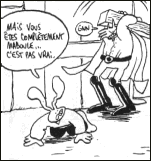
"Sly, funny, gorgeous," goes one rave on the net; "Hilarious," says another. The focus is on the sanguine title character and his mercurial pal Richard, and it's basically a satire on Parisian life. The drawing is cartoony, but with French production values (big pages, subtle colors) even cartoony looks good.
Trondheim has quite a range; he also takes Lapinot and friends into the Old West and the Middle Ages, does experimental comics, autobiographical comics, and ciel knows what else.
A dungeon which will be familiar to any D&Der, and the duck hired to defend it. The art is more involved than the Lapinot series, and the humor even sharper. It's also become an exceedingly ambitious series: there are half a dozen out, and literally over 300 planned...
The '60s stuff is pretty funny-- full of bad puns, language games, and cute historical jokes. The later stuff gets repetitive: you know that most comics heroes are going to win, but Astérix and Obélix never even get into deep trouble. Besides, the first, broader targets were more fun. The Brits were great; but really, the Belgians?
There are about 1,000 Astérix albums. Avoid Uderzo's solo albums like the clap. My favorites are Astérix et Cléopâtre, ("A bad character, but what a nose"), Astérix chez les Brétons (in which the Brits speak French as if translated literally from uppper-class twitspeak-- 'I say, rather' becomes 'Je dis, plutôt'), and Astérix chez les Goths (don't miss the druid competition).
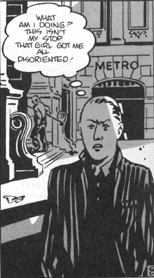 Alex Varenne
Alex Varenne
Kiro 1995
More palatable than the usual European erotica. Kiro is the most interesting of these, not least because it was originally published as manga, and has the leisurely quality of manga, as well as squarish balloons suitable for kanji, and a couple of pages you have to read right to left. The story concerns the amorous adventures of a young Japanese man in Paris. Varenne is a fantastic artist, with a stylish, loose line; one can't help however comparing his women to Jaime Hernandez's, and noticing that Varenne's are nearly lifeless, almost their only expression a seductive half-smile, no matter what they're doing-- while Jaime's women, tho' just as beautiful, are enormously expressive as well.
Dirty jokes-- very dirty. The style is one of elaborate, exaggerated ugliness, something that could have come out of '60s underground comix. But hey, he won the top prize at the '95 Angoulême comics festival.
The adventures of a sexy stewardess. These basically follow the Tintin formula of plucky protagonist, globe-trotting adventure, nefarious opponents, and frequent pratfalls, mostly experienced by Natacha's nebbishy boyfriend Walter. Natacha herself is a little too much of a '60s bombshell for me... give me Laureline any day.

